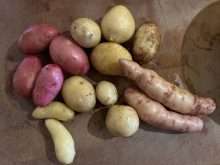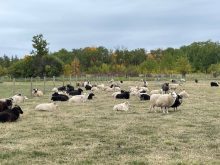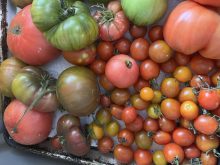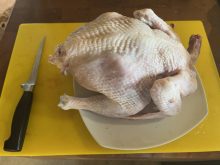You’ll recall that in my previous column, I posed the question of how many cookbooks a home cook really needs, and which new ones are worth buying or borrowing. Part of my research for this month’s column was to peruse the shortlist of nominees for the 2024 Taste Canada book awards. Several books appealed, but My Thali: A Simple Indian Kitchen, by Joe Thottungal with Ottawa food writer Anne DesBrisay, featuring stunning photos by Christian Lalonde, topped my list. This book focuses primarily on the food of Kerala, in the south of India, the land of coconut and rice.
“Yes, but dee,” I can hear you saying, “you already have a dozen South Asian cookbooks, so why would you consider adding another one to your shelf?”
Fair question. One reason is simply that I love South Asian food best — and as I went through the book last week, I flagged nearly every recipe as dishes I wanted to cook and eat. Another good reason was that this book is constructed around the notion of thali — a word like tagine or casserole, describing a physical dish as well as a meal. In this case, it’s a collection of small dishes, including pickles, raita, and chutneys, arrayed on a divided platter or — more traditionally — on a banana leaf. A thali centres around a starch — rice or bread — as opposed to a main course of protein and several sides, as we mostly eat in North America. Thali is how I have always liked to eat South Asian food; I just didn’t know it was a thing. And the recipes are vegetable-forward, which has always appealed to me and my veg-loving hungry tummy.
Read Also

Gentle treatments for pain in the neck
Heading toward year-end, people unknowingly tense up against the cold and busyness, causing neck pain that can often be treated with appropriate support and gentle mobility, athletic therapist Kathlyn Hossack says.
Joe has serious credentials as a writer and chef. He owns two restaurants in Ottawa, and in 2008 was named chef of the year by the Canadian Culinary Federation. In 2016, he won gold at Ottawa’s Gold Medal Plates and followed that with a silver medal at the 2017 Canadian Culinary Championships. His first book, Coconut Lagoon, won gold at Taste Canada’s 2020 Book Awards. My Thali has won two book awards to date: Taste Canada’s Regional/Cultural Award, and the Gourmand World Cookbook Award for India. Despite those accolades, he wanted to present home cooking in his second book. Personally, I can’t wait to cook my way through this collection, and I am really impressed by the photos of several thali, and the list of recipes used in each, that occupy the centre of the book.

Ingredients are front and centre in South Asian cooking, and this book’s opening pages explain spices and pantry ingredients, plus an insightful page on how to deal with fresh coconuts, which have forever baffled me with their impenetrable exterior.
Building a collection of dishes for a thali need not be a daunting task. In a recent interview with CBC Radio’s Sonali Karnick, Joe suggested making a different dish for supper each day, then at the weekend, using the leftovers to construct a thali. A lentil dal and a simple bowl of rice are his favourite essential core dishes for a thali. So first we eat, then we discuss what dishes to include in our own thali.

Dal makhani
Adapted from My Thali by Joe Thottungal and Anne DesBrisay. As Joe notes in his interview with Sonali Karnick, the food of Kerala almost always includes coconut, and is easily converted into vegan dishes. In this luxurious everyday dal, I swapped out the traditional butter for coconut oil and replaced whipping cream with coconut milk. Because I prefer the texture of Great Northern beans, I substituted them for Joe’s kidney beans and avoided the terrible texture of wintertime supermarket tomatoes by using my own Roasted Tomato Sauce from my freezer. Serves 6-10.
- 1 ½ cups black lentils
- ½ cup kidney or Great Northern beans
- 1 Tbsp. salt
- ¼ c. butter or coconut oil
- 8 green cardamom pods, cracked
- 3 black cardamom pods
- 5 whole cloves
- 4 Indian bay leaves
- 1-2 hot chilis, minced
- 1 cinnamon stick
- 1 Tbsp. cumin seed
- 3 large garlic cloves, minced
- 1 Tbsp. minced fresh ginger
- 2 onions, minced
- 2 Tbsp. paprika
- 1 Tbsp. chili powder
- 3 c. diced fresh tomato or Roasted Tomato Sauce
- 1 c. whipping cream or coconut milk
- ¼ c. minced cilantro, for garnish
Cook the lentils and beans with salt and plenty of water. When tender, drain, reserving half of the cooking water.
Melt the butter or coconut oil in a sauté pan. Add the whole spices and sauté for two minutes, then add the garlic and ginger, cooking for another minute, until fragrant. Add the onions and let them brown a bit as they cook. Add the remaining spices, stir, and sauté for a minute.
Add the tomatoes or Roasted Tomato Sauce and simmer for several minutes, then stir in in the cooked lentils and beans with some of the cooking water. Simmer. Add whipping cream or coconut milk, simmer for a few minutes, garnish, and serve.















